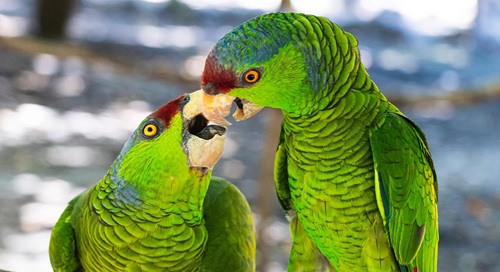Parrots are one of the most popular pet birds in India due to their vibrant colors, intelligence, and ability to mimic sounds. Among breeders, hobbyists, and pet owners, distinguishing between male and female parrots is important for breeding, health management, and understanding behavioral patterns. Unlike some animals, many parrot species do not have obvious external differences, making identification challenging. However, careful observation of physical traits, behavior, and scientific methods can help determine the sex of a parrot.

1. Physical Differences (Sexual Dimorphism)
Some parrot species exhibit sexual dimorphism, meaning males and females have distinct physical characteristics:
- Budgerigar (Budgie):
- Male: Cere (the fleshy area above the beak) is blue.
- Female: Cere is white, light brown, or tan, depending on maturity.
- Indian Ringneck Parrot:
- Male: Develops a distinctive colored ring around the neck (black or pink) after 1–2 years of age.
- Female: Ring is absent or faint, making it harder to differentiate before maturity.
- Macaws and African Grey Parrots:
- Often, males and females look similar externally. Subtle differences may include size, head shape, or tail length, but these are not reliable for all species.
Tip: For species without clear sexual dimorphism, physical observation alone may not be sufficient.
2. Behavioral Differences
Behavior can also provide clues about the sex of a parrot:
- Vocalization:
- Males are often more vocal and talkative, mimicking words and sounds more frequently.
- Females may be less talkative but can show strong protective instincts.
- Aggression and Territorial Behavior:
- Male parrots tend to be more territorial, especially during breeding season.
- Females are often nurturing and protective, particularly when nesting.
- Courtship Behavior:
- Males perform displays such as wing flapping, head bobbing, or presenting food to attract females.
- Females may respond by accepting or rejecting the advances, which can help identify sex during breeding.
3. Physical Measurements
In some species, size differences are a clue:
- Male parrots are often slightly larger and heavier than females.
- Head and beak size can also differ slightly in certain species, but this method is species-specific and not universally reliable.
4. DNA Testing
The most accurate method to identify a parrot’s sex is DNA testing:
- A feather, blood, or eggshell sample can be sent to a certified lab.
- DNA testing provides 99% accuracy, which is especially useful for species with no external sexual differences.
- Many breeders rely on DNA testing before pairing parrots for breeding.
5. Surgical Sexing (Endoscopy)
- In some cases, veterinarians perform endoscopy to visually examine the parrot’s reproductive organs.
- This method is invasive and usually a last resort but can provide definitive results for species that are difficult to sex externally.
Quick Identification Tips
| Feature | Male Parrot | Female Parrot |
| Cere Color (Budgies) | Blue | White, tan, or light brown |
| Neck Ring (Ringneck) | Prominent after 1–2 years | Absent or faint |
| Vocalization | Talkative, mimics sounds | Less vocal |
| Behavior | Territorial, displays courtship | Protective, nurturing |
| Size | Slightly larger in some species | Slightly smaller |
| DNA/Medical Testing | Confirms sex definitively | Confirms sex definitively |
Final Thoughts
Identifying male and female parrots requires a combination of observation, behavioral study, and scientific testing. For species with clear physical differences, visual cues like cere color or neck rings can help. In species without visible sexual dimorphism, DNA testing or veterinary examination is the most reliable method. Understanding the sex of parrots is important for breeding, proper care, and ensuring the well-being of these intelligent and social birds.